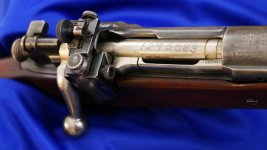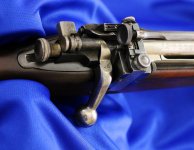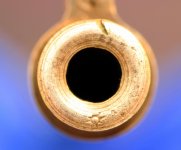This isn't a grail gun; it goes beyond that. I never thought I'd find one, and thus never set out on a quest for one. The official nomenlature is: "Rifle, US, Caliber 30, Model 1903, Sporting Type". But it's better known as the "NRA Sporting Rifle". I saw this rifle when I was in Ron Peterson's shop in Albuquerque this weekend and it's in my rifle rack now.
The NRA Sporter was produced between 1923 and 1938; only 5935 of them were made. My barrel is dated 8-28; 600 were made that year. The muzzle has a star at 6 O'Clock, indicating it was star gauged, as were all the NRA sporters. Originally a chart came with the rifle, showing the land and groove dimensions at one inch increments through the bore, but that is long gone. The cost from the Director of Civilian Markmanship that year was $46.00. The bolt and the top of the magazine follower are polished bright and the bolt is numbered to the rifle. The trigger pull and the cocking cams have recieved some hand workmanship. The buttplate is thicker than on the service rifle and is checkered. A Lyman 48 peep sight with a fairly long staff was standard equiment, although they could be special ordered drilled and tapped for a target telesopic sight with external adjustments. The workmanship is as good or better than anything available from the commercial arms companies at the time, and only exceeded by the hand workmanship from craftsmen like Owens or Griffin and Howe. There's slight blue wear on this one but the bore is pristine. I hope to shoot it this week, and if it wasn't so clumsy, I'd be sleeping with it under my pillow.
The NRA Sporter was produced between 1923 and 1938; only 5935 of them were made. My barrel is dated 8-28; 600 were made that year. The muzzle has a star at 6 O'Clock, indicating it was star gauged, as were all the NRA sporters. Originally a chart came with the rifle, showing the land and groove dimensions at one inch increments through the bore, but that is long gone. The cost from the Director of Civilian Markmanship that year was $46.00. The bolt and the top of the magazine follower are polished bright and the bolt is numbered to the rifle. The trigger pull and the cocking cams have recieved some hand workmanship. The buttplate is thicker than on the service rifle and is checkered. A Lyman 48 peep sight with a fairly long staff was standard equiment, although they could be special ordered drilled and tapped for a target telesopic sight with external adjustments. The workmanship is as good or better than anything available from the commercial arms companies at the time, and only exceeded by the hand workmanship from craftsmen like Owens or Griffin and Howe. There's slight blue wear on this one but the bore is pristine. I hope to shoot it this week, and if it wasn't so clumsy, I'd be sleeping with it under my pillow.




